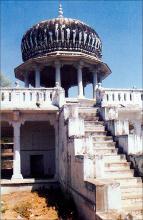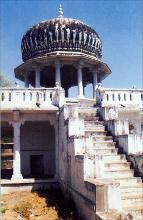| dc.coverage.spatial | Site: Hyderabad (Andhra Pradesh, India) | en_US |
| dc.coverage.temporal | creation date: first half 19th century | en_US |
| dc.creator | Unknown | en_US |
| dc.date | first half 19th century | en_US |
| dc.date.accessioned | 2007-09-28T17:24:04Z | |
| dc.date.available | 2007-09-28T17:24:04Z | |
| dc.date.issued | 1800-1850 | en_US |
| dc.identifier | 111193 | en_US |
| dc.identifier.uri | http://hdl.handle.net/1721.3/21420 | en_US |
| dc.description | Samadhi is a Sanskrit/Hindi word for cenotaph, a structure commemorating the dead akin to a tomb, but without remains. Given the profusion of Muslim tombs in Hyderabad, the Marwari moneylender Seth Puranmal Ganeriwal, who flourished in the first half of the 19th century built a domed pavilion approached by an open stairway, resembling an Islamic tomb, though cremation, not burial is the norm among upper caste Hindus. | en_US |
| dc.description | exterior, view of stairs and domed tomb, 2005 | en_US |
| dc.format.medium | masonry | en_US |
| dc.format.medium | stone | en_US |
| dc.relation.ispartof | 130586 | en_US |
| dc.rights | (c) Abbas Tyabji | en_US |
| dc.subject | Domes | en_US |
| dc.subject | Hinduism | en_US |
| dc.subject | Tombs | en_US |
| dc.subject | Cenotaphs | en_US |
| dc.subject | Islamic cities and towns | en_US |
| dc.subject | Architecture, Islamic --India | en_US |
| dc.subject | Sepulchral monuments | en_US |
| dc.subject | Pavilions | en_US |
| dc.subject | Hyderabad (India) | en_US |
| dc.subject | Stairs | en_US |
| dc.title | Puran Mal Samadhi | en_US |
| dc.type | Image | en_US |
| dc.rights.access | All rights reserved | en_US |
| vra.culturalContext | Hindu | en_US |
| vra.culturalContext | Indian (South Asian) | en_US |
| vra.technique | construction | en_US |
| vra.worktype | Cenotaph | en_US |
| dc.contributor.display | Hindu, Indian (South Asian) | en_US |



